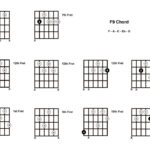For a seasoned guitar enthusiast, new instruments often need to offer something truly special to stand out. In today’s guitar market, dominated by mass-produced instruments, particularly those made overseas, skepticism is natural. However, the Squier J Mascis Jazzmaster arrived with a reputation that piqued interest, despite my usual reservations about guitars in this price range. Sent directly from J Mascis’s tech in the US, this guitar demanded a thorough examination.
Having spent years playing, owning, and working on Jazzmasters – from vintage ’59 models to modern iterations, including some of J Mascis’s personal guitars – and as a Jazzmaster player myself, I consider myself well-versed in the nuances of this iconic design. The Jazzmaster, in my opinion, represents Leo Fender’s pinnacle of guitar design, a perfect blend of form and function.
The concept of J Mascis, a celebrated guitarist known for his mastery of the Jazzmaster, endorsing a more affordable Squier version is immediately appealing. I’ve had experience with the Japanese signature sparkle purple Jazzmasters in the past, even owning one that was exceptional. However, the nature of running a guitar shop means sometimes letting go of instruments you’d personally prefer to keep. The idea of a signature model making a unique guitar style accessible to a wider range of players, especially younger musicians, is something I wholeheartedly support, and this Squier Jazzmaster seemed to fit that ideal perfectly.
While Fender and Squier have released numerous “offset” guitars over the years, many have deviated significantly from the original Jazzmaster blueprint. Jagmasters, HH Jags, and Blacktop models offer variations on the offset theme, but often lack the core specifications of a true Jazzmaster reissue. While the Squier J Mascis Jazzmaster isn’t a vintage-accurate reissue in the strictest sense, it’s arguably the closest you can get at this price point, and it’s a remarkably cool guitar in its own right.
 J Mascis Signature Squier Jazzmaster headstock featuring signature.
J Mascis Signature Squier Jazzmaster headstock featuring signature.
This release marks a significant moment: Fender has produced a Jazzmaster under the Squier banner that genuinely looks, plays, and sounds like a Jazzmaster, all at an incredibly accessible price. Throughout my evaluation, I found more to appreciate than to criticize, a testament to the thoughtful design and execution of this instrument.
Aesthetics and Finish: Blonde Beauty with a Few Modern Touches
First impressions matter, and the Squier J Mascis Jazzmaster immediately impresses with its visual appeal. The blonde finish paired with a gold pickguard is a classic and undeniably cool combination, arguably even more striking than the signature sparkle purple finish often associated with Mascis. The finish itself is excellent, consistent with the high standards of modern Asian-made guitars. It’s a thick, durable coat, perhaps leaning slightly towards a “fridge-like” sheen, but undeniably well-applied. A more transparent blonde finish might have allowed the wood grain to show through more prominently, but considering the price point, the overall aesthetic is outstanding.
Body and Neck: Tonewood and Playability
The body is constructed from solid basswood, a tonewood that sometimes receives criticism for being “generic” or lacking distinct tonal characteristics. However, I personally find basswood to be a perfectly acceptable and versatile body wood. In my experience, the type of wood used for the body has less influence on the overall tone than many believe. The neck is made from maple, specifically an Asian variety that is slightly softer than the North American maple typically used on higher-end Fender instruments. The neck finish is described as “satin,” but it feels closer to a gloss finish in hand. Interestingly, J Mascis reportedly requested an unfinished neck for both this Squier model and his Japanese signature version, but Fender opted for a finished neck.
The neck profile is a “C” shape that feels substantial, perhaps a touch thicker than my personal preference, with a subtle hint of a “V” profile. Despite the thickness, it remains comfortable and easy to navigate. The rosewood fretboard is a quality piece of wood, and the fretwork is surprisingly well-executed for a guitar in this price range. The neck is straight and well-finished, requiring no immediate fret dressing – a step I often find necessary on new guitars from this region. While I typically prefer medium-jumbo or vintage-style frets, the jumbo frets on this Jazzmaster are well-dressed and don’t cause any buzzing. The thicker neck and jumbo frets are clearly features tailored to J Mascis’s playing style and preferences.
Bridge and Vibrato: Modern Modifications for Enhanced Performance
The bridge is a notable departure from vintage Jazzmaster specifications, featuring a Gibson-style Tune-o-Matic bridge – a common modification favored by Jazzmaster players, including J Mascis himself. However, the most significant modification lies in the vibrato system’s placement. The vibrato unit is positioned approximately 15mm closer to the bridge compared to a traditional Jazzmaster. This seemingly small change addresses a common issue with vintage Jazzmasters: strings popping out of the bridge saddles during aggressive playing. By moving the vibrato closer, Fender has increased the string angle over the bridge, resulting in greater downward pressure. This clever modification achieves two crucial improvements: it dramatically reduces string pop-out and enhances sustain and overall tonal resonance. This is a brilliant design choice and a testament to the collaborative effort between J Mascis and Fender.
The vibrato unit itself is the standard Jazzmaster style, but without the lock mechanism found on some vintage models. The vibrato arm is slightly shorter than a standard reissue arm, likely to compensate for the repositioned vibrato unit. A standard length arm might extend too far towards the neck with the modified vibrato placement. The vibrato functions smoothly and is adjustable for tension, just like a traditional Jazzmaster vibrato.
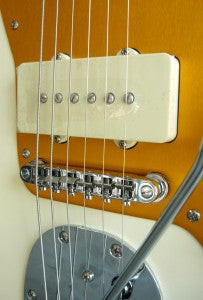 Squier J Mascis Jazzmaster vibrato arm and controls.
Squier J Mascis Jazzmaster vibrato arm and controls.
Pickups: P-90 Power in Jazzmaster Disguise
The pickups are perhaps the most significant deviation from traditional Jazzmaster specifications and a point of particular intrigue. Vintage Jazzmaster pickups are known for their broad, flat single-coil design, producing a deep yet articulate tone ideally suited for, as the name suggests, jazz music. Later Jazzmasters sometimes featured different bobbin shapes, resulting in a brighter, more trebly tone. Japanese reissues often utilize what is essentially a Strat-style bobbin wound on a Jazzmaster flatwork, yielding a thinner, more Strat-like sound.
However, the Squier J Mascis Jazzmaster features pickups that are fundamentally P-90s, cleverly disguised under standard Jazzmaster pickup covers. These pickups share the core construction of P-90s: adjustable pole pieces running through the bobbin and two bar magnets positioned on either side underneath. While technically not true Jazzmaster pickups, P-90s are renowned for their powerful, thick tone, and in this application, they sound exceptional. If you’re strictly pursuing a traditional, vintage Jazzmaster tone, swapping the pickups might be necessary. However, considering the guitar’s overall price, upgrading pickups is a financially viable option if desired.
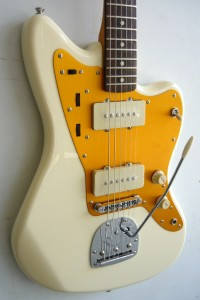 Close-up of the Squier J Mascis Jazzmaster P-90 style pickup.
Close-up of the Squier J Mascis Jazzmaster P-90 style pickup.
Personally, I find these P-90-style pickups to be a major strength of this guitar. They retain the single-coil clarity and “bark” but with a richer midrange and fuller low-end response compared to typical Jazzmaster pickups. Even with high gain settings, these pickups maintain clarity and definition remarkably well, arguably outperforming even US-made reissue Jazzmaster pickups in high-gain scenarios.
Electronics and Hardware: Functional and Reliable
The electronics are of average quality, but perfectly functional and, notably, better than many Chinese-made guitars I’ve encountered. The control cavities and pickguard are shielded, and the output jack features a dedicated ground connection. The switches operate smoothly and silently, with no unwanted crackling or noise.
Playability and Setup: Ready to Rock Right Out of the Box
Straight out of the box, the Squier J Mascis Jazzmaster played surprisingly well. After fitting my preferred 11-52 gauge strings and allowing the guitar to acclimate, a quick adjustment to the action and intonation was all that was needed to achieve optimal playability. Remarkably, I didn’t even find it necessary to perform a fret dress or adjust the nut height or truss rod, further highlighting the impressive factory setup.
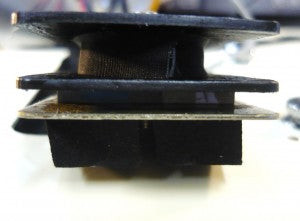 Full body shot of the Squier J Mascis Jazzmaster in blonde finish.
Full body shot of the Squier J Mascis Jazzmaster in blonde finish.
Conclusion: An Outstanding Offset for the Price
In conclusion, the Squier J Mascis Jazzmaster is the closest you’ll get to a high-quality Jazzmaster experience at an affordable price. If signature models aren’t your preference, the only visible signature is discreetly placed on the back of the headstock (and a less subtle one on the front of this review model), remaining unseen during performance. For offset guitar enthusiasts, this instrument is exceptional value for money. It captures the iconic Jazzmaster aesthetic and feel, incorporating thoughtful modern modifications that enhance playability and tone without detracting from the guitar’s core appeal. With the exception of the relocated vibrato – a positive improvement – most features can be modified to vintage specifications if desired.
Given its incredibly accessible price point, investing in a professional setup and, potentially, a set of vintage-spec Jazzmaster pickups will still result in a fantastic sounding and playing offset guitar at a fraction of the cost of a vintage instrument or high-end reissue. If I were in the market for a Jazzmaster and couldn’t justify the expense of a vintage model or a pricier reissue, the Squier J Mascis Jazzmaster would be my top choice, likely even purchasing multiple. Whether this model becomes a limited run or an ongoing production instrument remains to be seen, but Fender is undoubtedly poised to sell a significant number of these guitars. Anyone seeking an offset guitar that looks, plays, and sounds fantastic at an unbeatable price should seriously consider the Squier J Mascis Jazzmaster. After all, what’s better than a great expensive guitar? A great cheap one.
(Reference to EH JM Big Muff Blog – as per original article’s ending): For further reading on J Mascis’s signature gear, check out this blog post about the new EH JM Big Muff.
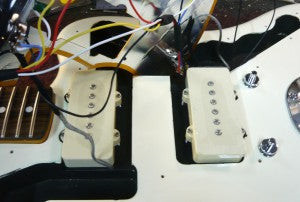 Pedalboard featuring the EH J Mascis Big Muff pedal.
Pedalboard featuring the EH J Mascis Big Muff pedal.

